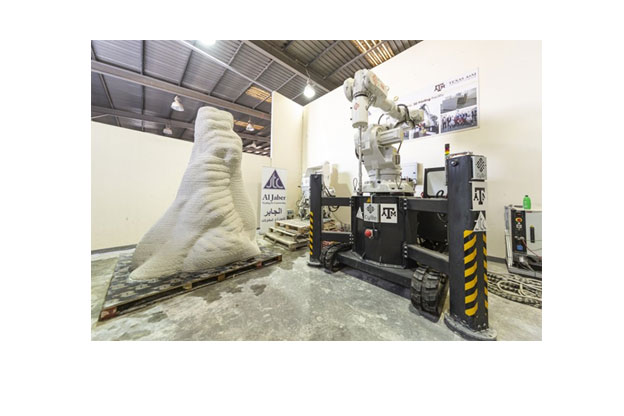Qatar’s First Concrete 3D Printed Sculpture

The country’s first 3D printed concrete structure is a local favourite – the Flag of Glory sculpture — a representation of diverse hands united in holding up the flag of Qatar. It was printed in Qatar’s only facility for concrete 3D printing, established as a result of a partnership between Texas A&M University at Qatar, a Qatar Foundation partner university, Al Jaber Trading and Contracting (JTC), and Cybe Construction.
3D printing has received increasing attention in the past decade, some industries found success in it early on, others like the construction industry struggled to catch up until very recently. Several 3D printed concrete structures are now popping up around the world.
Qatar has recently joined this international movement with its first 3D-printed concrete structure. “We choose to print this particular sculpture because of its significance to the country, and the diversity it symbolises,” said Dr. Eyad Masad, Professor in the Mechanical Engineering Program at Texas A&M University at Qatar (TAMUQ), who was critical in bringing concrete 3D printing technology to Qatar.
“From a technical aspect, this sculpture offers us the opportunity to showcase one of the biggest advantages of 3D printing which is flexibility in geometry.
With a structure like this, conventional construction practices would require designing and making a mould first, 3D printing allows us to skip that step completely allowing considerable cost savings.” Engr. Mohammed Al Hamayda, JTC’s General Manager, said: “TAMUQ and JTC operators are now fully trained to 3D print any complex object using concrete locally.
Our ultimate mutual goal is to participate effectively in developing green construction practices in Qatar in line with its National Vision 2030. The possibilities with 3D printing are endless and we look forward to partnering with the public and private construction sector as well as academic institutions to deliver rapid and sustainable construction in Qatar.”
3D concrete printing is an alternative construction method that has the potential to revolutionize the construction industry globally, with significant benefits such as reduced manpower; greater geometric freedom; reduced material consumption and wastage; improved safety on-site.
The ultimate goal of the group is to use demolished waste from construction and recycle it back into the construction sector through 3D printing. This work is currently being conducted with funding support from QF’s Qatar National Research Fund (QNRF) and in partnership with QF’s Hamad Bin Khalifa University (HBKU), Al-Jaber Trading and Contracting, Ashgal, Seero Engineering, and Hecettepe University in Turkey.
On the research side of the technology, experts from TAMUQ are looking into developing local materials for printing. “If you want to print structures in Qatar, you need to produce the printing material in Qatar. Shipping it is not a sustainable o p t i o n a l , n e i t h e r economically nor environmentally,” said Dr. Masad.
A major material property to focus on for construction in a country like Qatar is thermal conductivity. The group is currently exploring printing with a light material that has low thermal conductivity so it can provide insulation and essentially create smart structures. As of now, no regulations exist in Qatar to get 3D printed buildings approved for residential or commercial use.
To make inhabitable 3D printed buildings a reality, the government would need to develop electrical, plumbing, structural integrity, and public safety code standards. Dr. Masad noted that TAMUQ and JTC have worked very hard for the past year and a half to adopt this technology in Qatar.
The learning curve leading up to the deployment was a steep one, the team had to learn the design process, familiarize themselves with the printing material and its properties, understand how the printer operates and train personnel.
He said: “We are pleased to say, we have successfully managed to integrate all this knowledge and are now confident in our ability to deliver 3D printed concrete structures for Qatar.” Standing at a height of almost three meters, the structure took only 30 minutes to print and required two personnel to monitor the printing, and add the printing material.
The same structure, if constructed using conventional methods, would have taken 12 to 18 hours and at least five people.






108 Comments